Stretches to Do at Your Desk for Back Pain
Last Updated: Sept 11th, 2020
According to research by the American Chiropractic Association, back pain ranks as the #1 cause of disability worldwide. Unsurprisingly, it is the top reason for missing work, resulting in lost wages and huge financial stress.
Stretching and moving the back periodically is one of the most effective ways to keep back pain at bay, and even for existing back pain sufferers, significantly improve the condition, according to a study that involved over 4,300 participants.
To make it easy to engage your back even at work, I've come up with 14 of the best lower and upper back stretches you can do even at your office desk, whether you're sitting down, standing up, or on the floor occasionally.
Seated Chair Stretches
The key to a strong back in the office is to engage and stretch it often, to release tension build up and bring blood circulation to that region.
Even when you're stuck sitting at your desk, there are a number of stretches you can do that benefits the back. Here are some that can be performed without even leaving your chair.
1. Seated Pigeon Trunk Twist
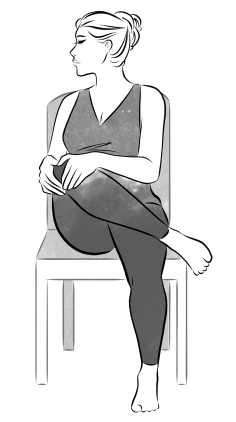
(Original illustrations by Ergonomic Trends)
One of my favorite lower back stretches, this one opens up your stiff lower back, hips, and even gives your legs a good stretch.
- Sit upright with your feet firmly on the ground.
- Put your right ankle on your left thigh.
- Using both hands, grab your right knee and slowly lift it towards you.
- Take a deep breath to stretch out the spine.
- Exhale while twisting your body to the right.
- Hold this position for 2 seconds.
- Inhale and slowly release to return to original position.
- Do the same steps to your left side.
2. Seated Forward Fold Stretch
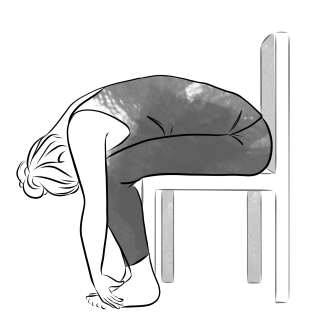
The seated forward fold removes the tension in the neck, shoulders, lower back, and hips all in one go. A perfect stretch for long hours of work, it can also lowers your blood pressure.
- Sit on a chair with your knees together and feet flat on the floor.
- Breathe. On the exhale, round your shoulders and bend forward one vertebrae at a time.
- Let your head drop completely and arms fall naturally by your sides.
- Hold this position for 3 seconds before slowly returning to the starting position.
3. Downward Facing Dog Stretch

The seated downward facing dog pose elongates the upper and lower back and chest. It also stretches the hamstring and increases the movement range of the hips.
- Sit upright with your feet flat on the floor.
- Raise your hands overhead.
- Slowly bend forward until your forearms are flat on the desk with your palms face down..
- Hold this position for 5 seconds before slowly releasing.
4. Seated Neck and Back Bend (Eagle Arch)
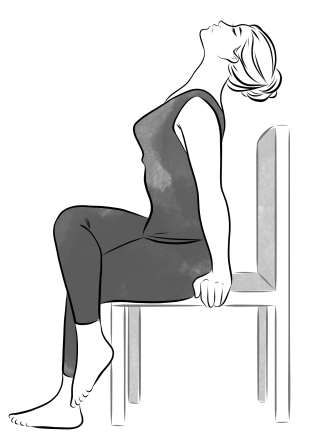
Over time, sitting in front of the computer for long periods of time can lead to rounded shoulders and back. To counter this hunched posture, stretch your neck, shoulders, back, and core by doing the eagle arch. This pose is also great for relieving pain when sitting with sciatica.
- Sit at the edge of your chair with your back straight.
- Place your arms slightly behind you and grasp the edge of the chair.
- Cross your right leg over your left.
- Connect the outer ankle of your right leg to the outside shin of your left leg.
- If you can, wrap your right foot around your left shin.
- Keeping your arms straight by pressing down on your hands, inhale and slowly arch your entire back.
- Tense your abs and keep your trunk engaged.
- Stay in this position for 5 seconds, slowly breathing in and out.
- Slowly return to your original position and repeat on the other side.
Standing Stretches
You're probably aware already of the benefits of standing periodically at work. Take it to the next level by doing the following simple back engaging streches while you're standing to amplify the benefits.
1. Overhead Shoulder Stretch
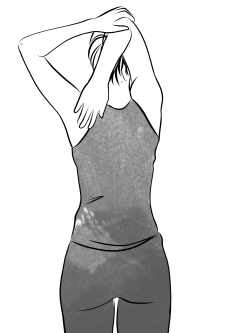
The overhead shoulder stretch is an awesome stretch that puts your body back into proper postural alignment. It also rejuvenates the neck, shoulders, and upper back.
- Begin with your body facing forward
- Raise one arm directly overhead and bend it at the elbow
- Catch the elbow with your opposite hand
- Pull the upright arm towards the opposite side and hold for 5 seconds. Feel a stretch along your entire arm and obliques.
- Repeat the stretch on the other side.
2. Standing Side Trunk Stretch
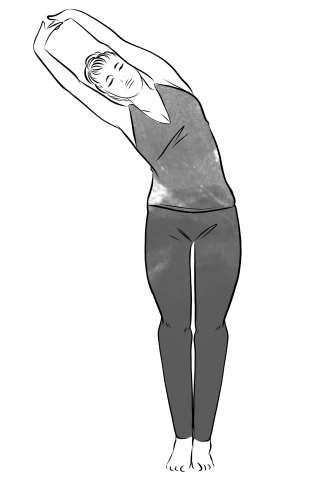
Release all that tension build-up around your spine and obliques by doing the standing side stretch.
- Begin with an upright standing position.
- Raise your hands towards the ceiling and interlock your fingers, palms facing the ceiling.
- Keeping your elbows straight, slowly bend your trunk to the side.
- Bend as far as you can and hold this position for 5 seconds.
- Do the stretch on the other side.
3. Standing Back bend Stretch
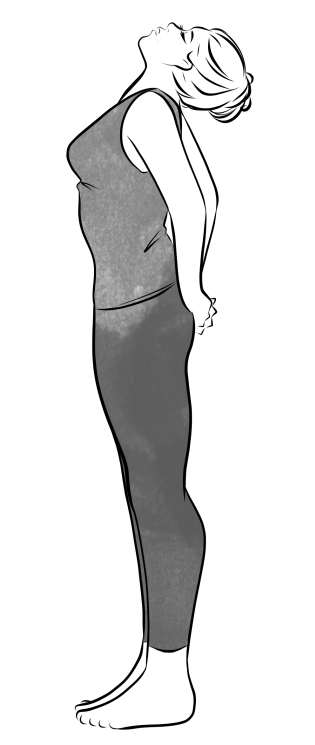
The standing back bend improves the flexibility of the lower back and spine. It also boosts the cardiovascular, digestive, and respiratory system.
- Stand upright with feet slightly apart.
- Place your hands on your lower bank with fingers interlaced and index finger pointing down.
- Push down into your feet, draw your knees up, and tighten your thighs and back.
- Roll back your shoulders and arch your lower spine as much as possible. Stretch your arms downwards for more leverage.
- If your balance is good, you can also drop your head back.
- Hold for 5 seconds.
- Inhale to lift up your torso, followed by the head and neck, to return to your starting position.
- Repeat this stretch 2 – 3 times.
4. Twister Pose Stretch
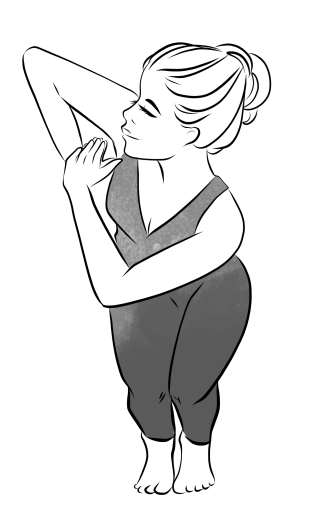
The twister pose, or revolved chair pose, strengthens the thighs, buttocks, and hips while improving the flexibility of the back and spine. It relieves neck and shoulder stiffness and boosts the metabolism and internal organs.
- Stand straight with feet together and hands at the sides.
- Bend your knees and sit low until your thighs are almost parallel to the floor.
- Bring your hands together, as if you were praying, at your chest.
- Twist your torso/ lower trunk to the right.
- Your left elbow should be outside your left knee while your right elbow is pointed upwards.
- Stay in this position for 30 seconds to 1 minute.
- Repeat stretch on the other side.
Floor Stretches
Unlike standing and seated stretches which can be done almost anywhere, floor stretches require a clear floor area. However, they typically allow you to target more muscle groups. Just add a towel and you're ready to go.
1. Plank Exercise (Low Plank)

Low planks are one of the best exercises to strengthen your back and core muscles. However, if you already have existing back pain, it's best to consult your doctor first.
- Lie on your stomach on the floor. You forearms should be flat on the floor with your elbows slightly below your shoulders.
- Lift your body up a few inches until your body forms a straight line (trunk, buttock, and lower limbs).
- Engage your core, keep your legs firm, and flex your feet.
- Maintain a neutral head position.
- Hold for 20 seconds to start before lowering yourself to the floor.
- As you get stronger, try to hold the position for longer periods.
2. Seated Stretch
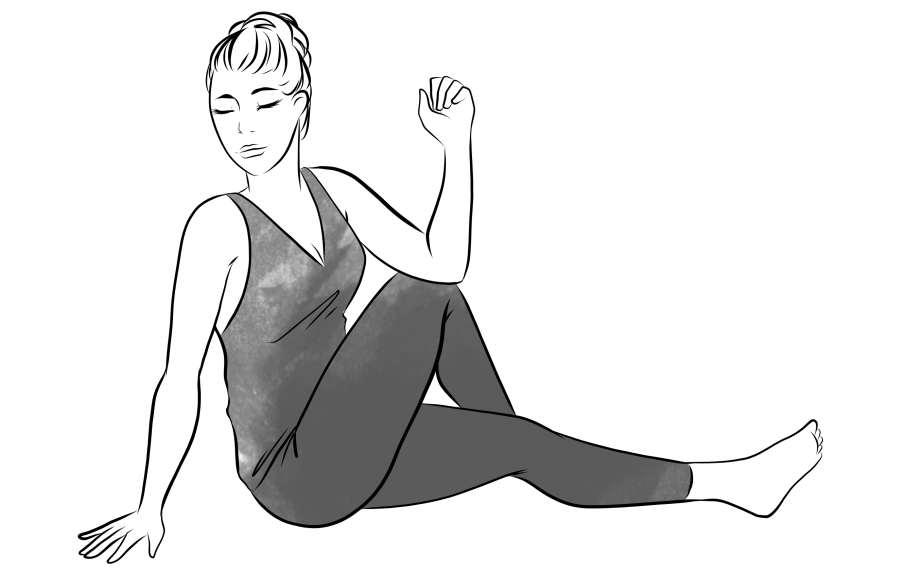
The seated stretch tones and improves the flexibility of the spinal flexors and obliques so that they can better support the spine.
- Begin by sitting with your legs extended in front of you.
- Cross your right leg over your left thigh.
- Place your right foot right beside the outer side of your left knee.
- Place your left elbow outside your right knee and right arm on the floor with a straight elbow.
- Twist your lower trunk to the right as you use your left arm to push your left leg in the opposite direction.
- Look over your shoulder.
- Hold this position for 10 seconds.
- Do the same stretch on the other side.
3. Glute Bridge Stretch
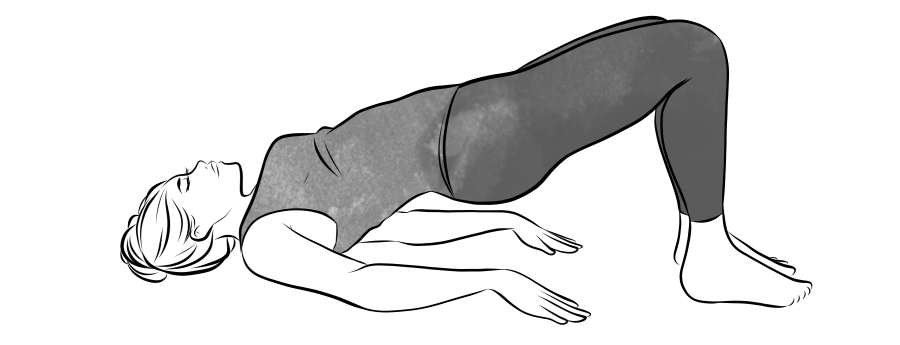
The glute bridge focuses on your glutes, quads, and core. It also strengthens the lower back while improving hip mobility.
- Lie down on the floor with your knees bent.
- Keep your palms face down at your side.
- Lift your body until shoulders and knees form a straight line.
- Squeeze your glutes and engage your core.
- Hold this position for 5 seconds before gently backing down.
4. Child's Pose Stretch

The Child's Pose is a beginner yoga resting pose that boosts digestion, calms the mind, massages the abdominal muscles, and relaxes the muscles in the hip area. More importantly, it naturally stretches the vertebrae to reverse the effect of working in front of the computer all day.
- Begin by kneeling on all fours.
- Keep the back flat and maintain a neutral head and neck alignment.
- Exhale and lower your buttocks on your heels.
- Slowly start to bend forward and eventually rest your forehead on the floor. Feel a stretch in the back of your neck.
- Keep your knees together or slightly apart.
- Extend your arms in front of you with your palms on the floor.
- Take slow deep breaths.
- On each inhale, press your stomach against your thighs.
- Do this for 4 to 12 breaths.
- Inhale slowly as you lift your upper body until you reach a seated position.
Also consider kneeling and squatting periodically, which open up your hips and are less strenuous on your back than sitting.
5. Supine Twist Stretch

The supine twist stretch does wonders for back pain and sciatica. It lengthens the lumbar area, hamstrings, and thighs while also realigning your spine and hydrating the spinal disks.
- Make a T position by lying on your back and bring your arms to the side.
- Bend your right knee and rest your right foot on your left knee.
- Keeping your shoulders flat, drop your right knee to the left side of your body.
- Twist your spine and lower back and look at your right fingertips.
- Relax into the position and let gravity naturally pull your knee down.
- Hold for 6 to 10 breaths.
- Stretch the other side.
6. Trunk Twist Stretch

The trunk twist stretch is a great way to keep your lower back muscles flexible and reduce the tension around the spine, hamstrings, and glutes. It also strengthens the core and improves posture and balance.
- Lie on your back with your knees bent and feet flat on the floor.
- Spread your arms to the side with your palms face down.
- Tense your abdominal muscles.
- Left your legs up so your shins are parallel to the floor
- Stay in control as your slowly twist your lower trunk and rotate your legs to one side, keeping your core engaged.
- Keep this position for 3 to 5 seconds.
- Engage your core again while slowly moving your legs to the other side.
- Hold for 3 to 5 seconds.
- Repeat for a few times.
Benefits of Stretching
Many people see stretching as a waste of time in the absence of any sweating or grunting as they perform a backward bend or an overhead shoulder stretch. But is it precisely the low intensity nature of stretching that brings unique benefits to the body that cannot be substituted by more rigorous exercises.
Medical experts say stretching does a lot more than just warm up our bodies. It helps increase blood circulation to neglected parts of your body, to key to preventing and healing injuries, such as lower back pain. Frequent stretching has also been found to improve posture, increase your range of motion, and decrease stress and headaches. And since it's so low intensity, stretching is the perfect routine to adopt at the office.
Conclusion
The key to preventing back pain or improving your condition is to strengthen your back muscles and bring vital nutrients to that area. All of the above stretches have been carefully chosen to be as accessible as possible in the office, and specifically, at your desk.
When sitting, there are also best practices you should follow to prevent your back pain from getting worse.
Related Resources
- Best Ergonomic Exercises at the Office Desk
- Best Office Chairs for Back Pain
- Best Office Chairs for Sciatica
- Best Office Chairs for Hip Pain
- 8 Best Hand and Wrist Exercises for Computer Users
- 5 Alexander Technique Exercises You Must Try For your Posture and Back Pain
- Reasons you Have Neck and Shoulder Pain at the Computer (How to Fix It)
Stretches to Do at Your Desk for Back Pain
Source: https://ergonomictrends.com/best-stretches-to-improve-back-pain-at-the-desk/